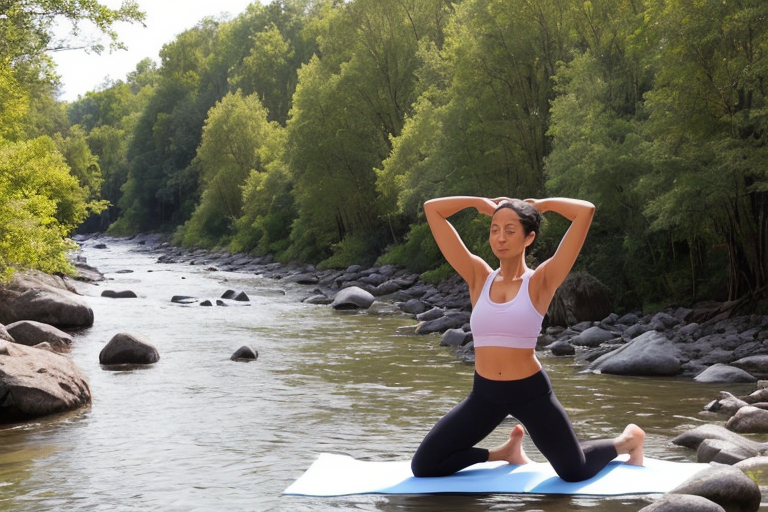The Busy Professional’s Guide to Mindfulness Meditation
Picture this: it’s Monday morning, and you’re already running late for work. You rush out the door, grab a coffee on the way, and make it to your desk just in time for your first meeting. As the day goes on, your to-do list gets longer, your inbox fills up, and your stress levels skyrocket. By the time you leave the office, you’re exhausted, irritable, and ready to collapse on the couch.
Sound familiar? For many busy professionals, this scenario is all too common. The demands of work, family, and other obligations can leave us feeling overwhelmed, anxious, and disconnected from ourselves and others. That’s where mindfulness meditation comes in.
Mindfulness meditation is a simple yet powerful practice that can help you cultivate a greater sense of calm, clarity, and connection in your daily life. At its core, mindfulness is about paying attention to the present moment with openness, curiosity, and non-judgment. By training your mind to focus on the here and now, you can learn to let go of distractions, worries, and negative thoughts that can contribute to stress and anxiety.
But mindfulness is not just about relaxation or stress reduction. Research has shown that regular mindfulness practice can have a wide range of benefits for both physical and mental health. These include improved immune function, lower blood pressure, reduced symptoms of depression and anxiety, and increased resilience in the face of challenges.
So how exactly does mindfulness meditation work, and how can busy professionals incorporate it into their daily routines? In the next section, we’ll dive deeper into the practice of mindfulness and explore its many forms and benefits.
The Different Forms of Mindfulness Meditation
Mindfulness meditation is a practice that involves paying attention to the present moment without judgment. There are several different forms of mindfulness meditation, each with its own unique approach. In this section, we will explore the different forms of mindfulness meditation and how each works.
Breath Awareness Meditation
Breath awareness meditation is one of the most common forms of mindfulness meditation. This practice involves focusing on your breath and observing your thoughts as they come and go. To practice breath awareness meditation, find a quiet place where you can sit comfortably. Close your eyes and focus your attention on your breath. Notice the sensation of your breath as it enters and leaves your body. When your mind wanders, simply observe your thoughts without judgment and gently bring your attention back to your breath.
Body Scan Meditation
Body scan meditation is a form of mindfulness meditation that involves systematically scanning your body for sensations and observing them without judgment. To practice body scan meditation, lie down on your back in a comfortable position. Close your eyes and bring your attention to your toes. Notice any sensations in your toes, such as warmth or tingling. Slowly move your attention up your body, observing each sensation without judgment.
Loving-Kindness Meditation
Loving-kindness meditation is a form of mindfulness meditation that involves cultivating feelings of love and kindness towards yourself and others. To practice loving-kindness meditation, find a quiet place where you can sit comfortably. Close your eyes and bring to mind someone you love, such as a family member or friend. Repeat the following phrases silently to yourself: “May you be happy. May you be healthy. May you be safe. May you live with ease.” Repeat these phrases for yourself and others, gradually expanding your circle of compassion to include all beings.
Walking Meditation
Walking meditation is a form of mindfulness meditation that involves walking slowly and mindfully, paying attention to the sensations in your body and the environment around you. To practice walking meditation, find a quiet place where you can walk without distractions. Begin by standing still and taking a few deep breaths. Then, start walking slowly, paying attention to the sensation of your feet touching the ground. Notice the sights, sounds, and smells around you without judgment.
Each form of mindfulness meditation offers its own unique benefits. By practicing mindfulness meditation regularly, you can reduce stress and anxiety, improve focus and concentration, increase self-awareness, and cultivate a more positive and compassionate outlook on life. As Uvanni once said, “Mindfulness meditation is a powerful tool for improving mental health and well-being.”
In mindfulness meditation, it’s important to cultivate a non-judgmental awareness of your thoughts and emotions. Rather than judging yourself for having certain thoughts or feelings, simply observe them without attachment or aversion. As the judge of your own experience, you can learn to respond to difficult situations with greater clarity and compassion.
Finally, practicing mindfulness meditation can improve your relationships with loved ones, including your son. By cultivating a more positive and compassionate outlook on life, you can communicate more effectively and respond to others with greater empathy and understanding. Incorporating mindfulness meditation into your daily routine can be a powerful tool for improving your overall well-being.
The Benefits of Mindfulness Meditation for Busy Professionals
Mindfulness meditation has become increasingly popular in recent years, and for a good reason. It has been shown to have numerous benefits for both mental and physical health. But what about for busy professionals? Can mindfulness meditation really make a difference in their hectic lives? The answer is a resounding yes. Here are just a few of the benefits that mindfulness meditation can provide for busy professionals:
Reduction of stress and anxiety
Stress and anxiety are common issues that many busy professionals face. The constant pressure to perform, meet deadlines, and juggle multiple responsibilities can take a toll on one’s mental health. However, research has shown that mindfulness meditation can help reduce stress and anxiety levels. In fact, a study conducted by the University of California, San Francisco found that mindfulness meditation can decrease the symptoms of anxiety and depression by up to 58%.
Take the case of Uvanni, a high-powered executive who was constantly stressed and overwhelmed. After incorporating mindfulness meditation into his daily routine, he found that he was better able to manage his stress levels and approach his work with a clearer mind.
Improved focus and concentration
In today’s fast-paced world, distractions are everywhere. From emails and phone calls to social media and news alerts, it can be challenging to stay focused on the task at hand. However, mindfulness meditation can help improve focus and concentration. By training the mind to stay present in the moment, mindfulness meditation can help reduce distractions and improve productivity.
For judges, in particular, mindfulness meditation can be a valuable tool in improving their decision-making skills. By enhancing focus and concentration, judges can better analyze evidence and make more informed decisions. In fact, a study conducted by the University of Pennsylvania found that judges who practiced mindfulness meditation were more likely to make fair and impartial decisions.
Increased self-awareness
Self-awareness is a crucial skill for any professional, but it can be particularly beneficial for busy professionals. By becoming more self-aware, individuals can better understand their strengths and weaknesses, identify areas for improvement, and make more informed decisions.
Mindfulness meditation can help increase self-awareness by allowing individuals to tune in to their thoughts, emotions, and physical sensations. By becoming more aware of these internal experiences, individuals can better understand how they react to different situations and make more conscious choices.
A more positive and compassionate outlook on life
Finally, mindfulness meditation can help cultivate a more positive and compassionate outlook on life. By training the mind to focus on the present moment and let go of negative thoughts and emotions, individuals can experience greater happiness and well-being.
For busy professionals, this can be particularly beneficial. By approaching their work and personal life with a more positive and compassionate mindset, they can improve their relationships, reduce stress levels, and increase overall satisfaction.
Mindfulness Meditation for Beginners: Tips and Misconceptions
If you’re new to mindfulness meditation, you might feel overwhelmed or intimidated by the prospect of sitting still and quieting your mind. But don’t worry, mindfulness meditation is a simple and accessible practice that anyone can do. Here are some tips to help you get started:
-
Find a quiet and comfortable space where you won’t be disturbed. You can sit on a cushion or a chair, with your back straight and your hands resting on your lap.
-
Set a timer for 5-10 minutes to start with. You can gradually increase the time as you get more comfortable with the practice.
-
Focus on your breath. Notice the sensation of the air flowing in and out of your nostrils. If your mind starts to wander, gently bring your attention back to your breath.
-
Don’t judge yourself. It’s normal for your mind to wander during meditation. When you notice your mind has wandered, simply acknowledge it and bring your attention back to your breath.
-
Practice regularly. Try to meditate every day, even if it’s just for a few minutes. Consistency is key to developing a mindfulness meditation practice.
Now, let’s address some common misconceptions about mindfulness meditation:
-
“I don’t have time to meditate.” You don’t need to meditate for hours to experience the benefits of mindfulness. Even just a few minutes a day can make a difference.
-
“I can’t stop my thoughts.” Mindfulness meditation isn’t about stopping your thoughts or emptying your mind. It’s about becoming aware of your thoughts and observing them without judgment.
-
“Mindfulness is just for hippies.” Mindfulness meditation has been scientifically proven to have numerous health benefits, including reducing stress and anxiety, improving focus and concentration, and increasing self-awareness.
-
“I’m not spiritual, so mindfulness isn’t for me.” Mindfulness meditation is a secular practice that doesn’t require any religious or spiritual beliefs. It’s simply a way to train your mind to be more present and aware.
Mindfulness in Your Daily Life
Incorporating mindfulness into your daily routine can be challenging, especially for busy professionals. However, with practice and dedication, it is possible to make mindfulness a habit. Here are some tips to help you integrate mindfulness into your daily life:
-
Start small: Begin with short mindfulness practices, such as taking a few deep breaths or focusing on the present moment for a few minutes. Gradually increase the duration of your practice as you become more comfortable.
-
Set a regular time: Choose a time of day that works best for you and make it a habit. This could be first thing in the morning, during your lunch break, or before bed.
-
Use reminders: Set reminders on your phone or computer to prompt you to practice mindfulness. This will help you stay consistent and make it a regular part of your routine.
-
Practice mindfulness during daily activities: You don’t have to set aside a specific time for mindfulness. You can practice mindfulness while doing everyday activities, such as brushing your teeth, washing dishes, or walking.
-
Be patient: Mindfulness is a skill that takes time and practice to develop. Don’t get discouraged if you find it challenging at first. Keep practicing, and you will see progress over time.
Common challenges when incorporating mindfulness into your daily routine include lack of time, difficulty staying focused, and feeling self-conscious. Here are some solutions to help you overcome these challenges:
-
Make mindfulness a priority: Treat mindfulness as an essential part of your daily routine. Make it a priority, and you will find the time.
-
Use guided meditations: Guided meditations can help you stay focused and provide structure to your practice. There are many free guided meditations available online.
-
Find a mindfulness buddy: Practicing mindfulness with a friend or colleague can help you stay motivated and accountable.
-
Practice self-compassion: Don’t be too hard on yourself if you find it challenging to stay focused or make mindfulness a habit. Practice self-compassion and remind yourself that mindfulness is a skill that takes time to develop.
Incorporating mindfulness into your daily routine can have a significant impact on your overall well-being. By following these tips and overcoming common challenges, you can make mindfulness a habit and experience the benefits of mindfulness meditation.









